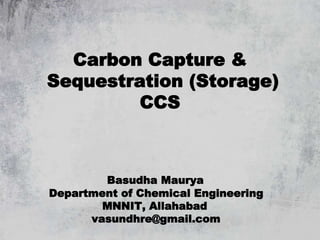Carbon-Capture-and-Sequestr.8201938.powerpoint.pptx
- 1. Carbon Capture & Sequestration (Storage) CCS Basudha Maurya Department of Chemical Engineering MNNIT, Allahabad vasundhre@gmail.com
- 2. 2 Presentation Outline ŌĆó Introduction ŌĆó CO2 Capture Processes & Separation Technologies ŌĆó CO2 Transportation & Storage ŌĆó Quality Specification of CO2 ŌĆó Monitoring & Mathematical expressions ŌĆó CCS Status in World & in India ŌĆó Alternative Approaches to Capture CO2
- 3. 3 By 2050, global population will rise from & the World energy demand is expected to increase by 50% over the next 20 years.
- 4. 4 We Still Rely on Fossil Fuels ŌĆó Fossil fuels (coal, gas and oil) represent 80% of the global energy supply ŌĆó Renewables supply only account for 13% of our total energy supply
- 5. 5 ŌĆ” and will Continue to do so for Decades to Come By 2030 Renewables could make upto 30% of the global energy supply ŌĆó But fossil fuels will remain our main source of energy for decades to come
- 6. 6 Fossil Fuels Power the Largest Emitters of CO2ŌĆ”. Fossil fuels power plants, heavy industry and refineries account for 52% of the worldŌĆÖs current CO2 emissions (15 billion tonnes CO2 emissions/year)
- 7. 7 CO2 emissions by industry & power plant EU GEOCAPACITY 2006
- 8. 8 CO2 emissions by region EU GEOCAPACITY 2006
- 9. 9 ŌĆ”and too Much CO2 Leads to Global Warming ŌĆó ŌĆ” which in turn, produces climate change ŌĆó Unless the rise in average global temperature is kept below 2┬░C, devastating and irreversible climate changes will occur. Muir Glacier, August, 2004 Muir Glacier, August, 1941
- 10. 10 How do we Meet this Challenge? ŌĆó We need to cut CO2 emissions fastŌĆ” ŌĆ” as energy consumption continues to rise ŌĆ”Our climate depends on it
- 11. 11 CCS alone will provide up to 20% of the CO2 emission reductions we need to make by 2050. HereŌĆÖs how it works...
- 12. 12 What Is Carbon Capture and Sequestration (Storage) Three stage process: i. Capturing CO2 at Large & stationary point sources ii. Transporting the CO2 from source to sink, iii. Injecting the CO2 in suited geological reservoir or sinks
- 13. 13 Inside CCS
- 14. 14 Carbon Capture Options ŌĆó Capture Processes: 1. Post-combustion :separation CO2-N2 2. Pre-combustion :separation CO2-H2 3. Oxy-fuel combustion :separation O2-N2 ŌĆó Separation technologies: 1. Adsorption 2. Absorption 3. Membrane Separation 4. Cryogenic distillation
- 15. 15 Separation principles 1.Adsorption: attachment of fluid to a solid surface ŌĆō Solid sorbents :Lime, zeolite, activated carbon 2.Absorption: fluid dissolves or permeates into a liquid ŌĆō Solvents :Aqueous amines and salts Chemical Adsorption Physical Adsorption Chemical Absorption Physical Absorption
- 16. 16 Separation principles 3.Membrane Separation: separation which makes use of difference in physical/chemical interaction with membrane ŌĆó Membrane provides grater contacting area
- 17. Interesting, right? This is just a sneak preview of the full presentation. We hope you like it! To see the rest of it, just click here to view it in full on PowerShow.com. Then, if youŌĆÖd like, you can also log in to PowerShow.com to download the entire presentation for free.
















